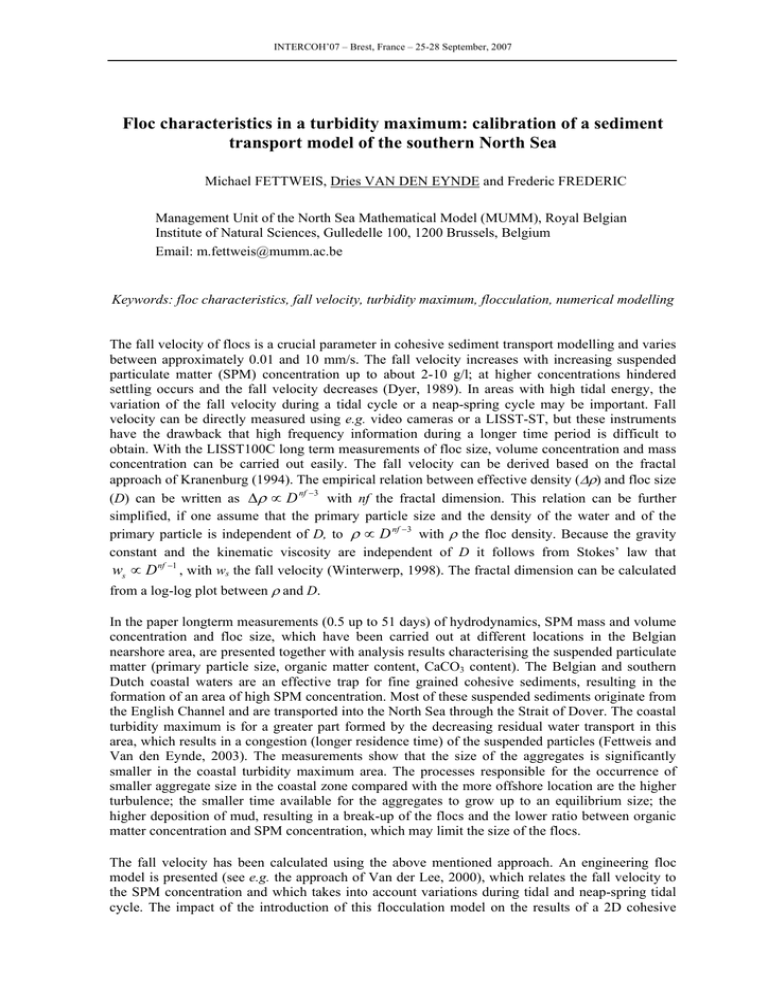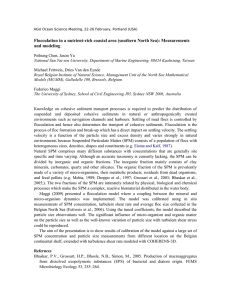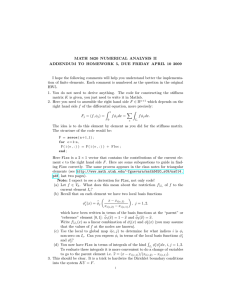Floc characteristics in a turbidity maximum: calibration of a sediment
advertisement

INTERCOH’07 – Brest, France – 25-28 September, 2007 Floc characteristics in a turbidity maximum: calibration of a sediment transport model of the southern North Sea Michael FETTWEIS, Dries VAN DEN EYNDE and Frederic FREDERIC Management Unit of the North Sea Mathematical Model (MUMM), Royal Belgian Institute of Natural Sciences, Gulledelle 100, 1200 Brussels, Belgium Email: m.fettweis@mumm.ac.be Keywords: floc characteristics, fall velocity, turbidity maximum, flocculation, numerical modelling The fall velocity of flocs is a crucial parameter in cohesive sediment transport modelling and varies between approximately 0.01 and 10 mm/s. The fall velocity increases with increasing suspended particulate matter (SPM) concentration up to about 2-10 g/l; at higher concentrations hindered settling occurs and the fall velocity decreases (Dyer, 1989). In areas with high tidal energy, the variation of the fall velocity during a tidal cycle or a neap-spring cycle may be important. Fall velocity can be directly measured using e.g. video cameras or a LISST-ST, but these instruments have the drawback that high frequency information during a longer time period is difficult to obtain. With the LISST100C long term measurements of floc size, volume concentration and mass concentration can be carried out easily. The fall velocity can be derived based on the fractal approach of Kranenburg (1994). The empirical relation between effective density (Δρ) and floc size (D) can be written as Δρ ∝ D nf −3 with nf the fractal dimension. This relation can be further simplified, if one assume that the primary particle size and the density of the water and of the primary particle is independent of D, to ρ ∝ D nf −3 with ρ the floc density. Because the gravity constant and the kinematic viscosity are independent of D it follows from Stokes’ law that ws ∝ D nf −1 , with ws the fall velocity (Winterwerp, 1998). The fractal dimension can be calculated from a log-log plot between ρ and D. In the paper longterm measurements (0.5 up to 51 days) of hydrodynamics, SPM mass and volume concentration and floc size, which have been carried out at different locations in the Belgian nearshore area, are presented together with analysis results characterising the suspended particulate matter (primary particle size, organic matter content, CaCO3 content). The Belgian and southern Dutch coastal waters are an effective trap for fine grained cohesive sediments, resulting in the formation of an area of high SPM concentration. Most of these suspended sediments originate from the English Channel and are transported into the North Sea through the Strait of Dover. The coastal turbidity maximum is for a greater part formed by the decreasing residual water transport in this area, which results in a congestion (longer residence time) of the suspended particles (Fettweis and Van den Eynde, 2003). The measurements show that the size of the aggregates is significantly smaller in the coastal turbidity maximum area. The processes responsible for the occurrence of smaller aggregate size in the coastal zone compared with the more offshore location are the higher turbulence; the smaller time available for the aggregates to grow up to an equilibrium size; the higher deposition of mud, resulting in a break-up of the flocs and the lower ratio between organic matter concentration and SPM concentration, which may limit the size of the flocs. The fall velocity has been calculated using the above mentioned approach. An engineering floc model is presented (see e.g. the approach of Van der Lee, 2000), which relates the fall velocity to the SPM concentration and which takes into account variations during tidal and neap-spring tidal cycle. The impact of the introduction of this flocculation model on the results of a 2D cohesive INTERCOH’07 – Brest, France – 25-28 September, 2007 sediment transport model is discussed. The model results are compared with the measurements. References Dyer, K. R. (1989) Sediment processes in estuaries: future research requirements. Journal of Geophysical Research, 94 (C10), 14327-14339. Fettweis, M. and Van den Eynde, D. (2003) The mud deposits and the high turbidity in the Belgian-Dutch coastal zone, Southern bight of the North Sea. Continental Shelf Research, 23, 669691. Kranenburg, C. (1994) On the fractal structure of cohesive sediment aggregates. Estuarine, Coastal and Shelf Science, 39, 451-460. van der Lee, W. T. B. (2000) The settling of mud flocs in the Dollard estuary, The Netherlands. PhD thesis, Universiteit Utrecht, 133pp. Winterwerp, J. (1998) A simple model for turbulence induced flocculation of cohesive sediments. Journal of Hydraulic Research, 36 (3), 309-326.


